转载 http://community.topcoder.com/tc?module=Static&d1=tutorials&d2=lowestCommonAncestor
Introduction
Notations
Range Minimum Query (RMQ)
Trivial algorithms for RMQ
A <O(N), O(sqrt(N))> solution
Sparse Table (ST) algorithm
Segment Trees
Lowest Common Ancestor (LCA)
A <O(N), O(sqrt(N))> solution
Another easy solution in <O(N logN, O(logN)>
Reduction from LCA to RMQ
From RMQ to LCA
An <O(N), O(1)> algorithm for the restricted RMQ
Conclusion
Introduction
The problem of finding the Lowest Common Ancestor (LCA) of a pair of nodes in a rooted tree has been studied more carefully in the second part of the 20th century and now is fairly basic in algorithmic graph theory. This problem is interesting not only for the tricky algorithms that can be used to solve it, but for its numerous applications in string processing and computational biology, for example, where LCA is used with suffix trees or other tree-like structures. Harel and Tarjan were the first to study this problem more attentively and they showed that after linear preprocessing of the input tree LCA, queries can be answered in constant time. Their work has since been extended, and this tutorial will present many interesting approaches that can be used in other kinds of problems as well.
Let's consider a less abstract example of LCA: the tree of life. It's a well-known fact that the current habitants of Earth evolved from other species. This evolving structure can be represented as a tree, in which nodes represent species, and the sons of some node represent the directly evolved species. Now species with similar characteristics are divided into groups. By finding the LCA of some nodes in this tree we can actually find the common parent of two species, and we can determine that the similar characteristics they share are inherited from that parent.
Range Minimum Query (RMQ) is used on arrays to find the position of an element with the minimum value between two specified indices. We will see later that the LCA problem can be reduced to a restricted version of an RMQ problem, in which consecutive array elements differ by exactly 1.
However, RMQs are not only used with LCA. They have an important role in string preprocessing, where they are used with suffix arrays (a new data structure that supports string searches almost as fast as suffix trees, but uses less memory and less coding effort).
In this tutorial we will first talk about RMQ. We will present many approaches that solve the problem -- some slower but easier to code, and others faster. In the second part we will talk about the strong relation between LCA and RMQ. First we will review two easy approaches for LCA that don't use RMQ; then show that the RMQ and LCA problems are equivalent; and, at the end, we'll look at how the RMQ problem can be reduced to its restricted version, as well as show a fast algorithm for this particular case.
Notations
Suppose that an algorithm has preprocessing time f(n) and query time g(n). The notation for the overall complexity for the algorithm is <f(n), g(n)>.
We will note the position of the element with the minimum value in some array A between indices i and j with RMQA(i, j).
The furthest node from the root that is an ancestor of both u and v in some rooted tree T is LCAT(u, v).
Range Minimum Query(RMQ)
Given an array A[0, N-1] find the position of the element with the minimum value between two given indices.

Trivial algorithms for RMQ
For every pair of indices (i, j) store the value of RMQA(i, j) in a table M[0, N-1][0, N-1]. Trivial computation will lead us to an <O(N3), O(1)> complexity. However, by using an easy dynamic programming approach we can reduce the complexity to <O(N2), O(1)>. The preprocessing function will look something like this:
void process1(int M[MAXN][MAXN], int A[MAXN], int N)
{
int i, j;
for (i =0; i < N; i++)
M[i][i] = i;
for (i = 0; i < N; i++)
for (j = i + 1; j < N; j++)
if (A[M[i][j - 1]] < A[j])
M[i][j] = M[i][j - 1];
else
M[i][j] = j;
}
This trivial algorithm is quite slow and uses O(N2) memory, so it won't work for large cases.
An <O(N), O(sqrt(N))> solution
An interesting idea is to split the vector in sqrt(N) pieces. We will keep in a vector M[0, sqrt(N)-1] the position for the minimum value for each section. M can be easily preprocessed in O(N). Here is an example:
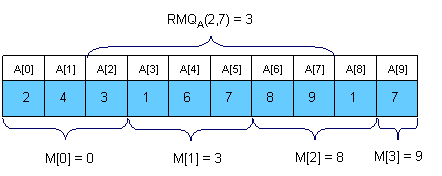
Now let's see how can we compute RMQA(i, j). The idea is to get the overall minimum from the sqrt(N) sections that lie inside the interval, and from the end and the beginning of the first and the last sections that intersect the bounds of the interval. To get RMQA(2,7) in the above example we should compare A[2], A[M[1]], A[6] and A[7] and get the position of the minimum value. It's easy to see that this algorithm doesn't make more than 3 * sqrt(N) operations per query.
The main advantages of this approach are that is to quick to code (a plus for TopCoder-style competitions) and that you can adapt it to the dynamic version of the problem (where you can change the elements of the array between queries).
Sparse Table (ST) algorithm
A better approach is to preprocess RMQ for sub arrays of length 2k using dynamic programming. We will keep an array M[0, N-1][0, logN] where M[i][j] is the index of the minimum value in the sub array starting at i having length 2j. Here is an example:
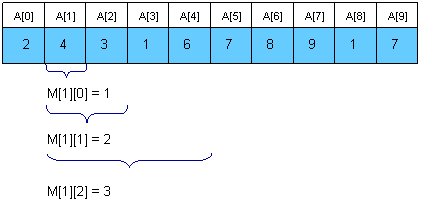
For computing M[i][j] we must search for the minimum value in the first and second half of the interval. It's obvious that the small pieces have 2j - 1 length, so the recurrence is:

The preprocessing function will look something like this:
void process2(int M[MAXN][LOGMAXN], int A[MAXN], int N)
{
int i, j;
//initialize M for the intervals with length 1
for (i = 0; i < N; i++)
M[i][0] = i;
//compute values from smaller to bigger intervals
for (j = 1; 1 << j <= N; j++)
for (i = 0; i + (1 << j) - 1 < N; i++)
if (A[M[i][j - 1]] < A[M[i + (1 << (j - 1))][j - 1]])
M[i][j] = M[i][j - 1];
else
M[i][j] = M[i + (1 << (j - 1))][j - 1];
}
Once we have these values preprocessed, let's show how we can use them to calculate RMQA(i, j). The idea is to select two blocks that entirely cover the interval [i..j] and find the minimum between them. Let k = [log(j - i + 1)]. For computing RMQA(i, j) we can use the following formula:

So, the overall complexity of the algorithm is <O(N logN), O(1)>.
Segment trees
For solving the RMQ problem we can also use segment trees. A segment tree is a heap-like data structure that can be used for making update/query operations upon array intervals in logarithmical time. We define the segment tree for the interval [i, j] in the following recursive manner:
- the first node will hold the information for the interval [i, j]
- if i<j the left and right son will hold the information for the intervals [i, (i+j)/2] and [(i+j)/2+1, j]
Notice that the height of a segment tree for an interval with N elements is [logN] + 1. Here is how a segment tree for the interval [0, 9] would look like:

The segment tree has the same structure as a heap, so if we have a node numbered x that is not a leaf the left son of x is 2*x and the right son 2*x+1.
For solving the RMQ problem using segment trees we should use an array M[1, 2 * 2[logN] + 1] where M[i] holds the minimum value position in the interval assigned to node i. At the beginning all elements in M should be -1. The tree should be initialized with the following function (b and e are the bounds of the current interval):
void initialize(intnode, int b, int e, int M[MAXIND], int A[MAXN], int N)
{
if (b == e)
M[node] = b;
else
{
//compute the values in the left and right subtrees
initialize(2 * node, b, (b + e) / 2, M, A, N);
initialize(2 * node + 1, (b + e) / 2 + 1, e, M, A, N);
//search for the minimum value in the first and
//second half of the interval
if (A[M[2 * node]] <= A[M[2 * node + 1]])
M[node] = M[2 * node];
else
M[node] = M[2 * node + 1];
}
}
The function above reflects the way the tree is constructed. When calculating the minimum position for some interval we should look at the values of the sons. You should call the function withnode = 1, b = 0 and e = N-1.
We can now start making queries. If we want to find the position of the minimum value in some interval [i, j] we should use the next easy function:
int query(int node, int b, int e, int M[MAXIND], int A[MAXN], int i, int j)
{
int p1, p2;
//if the current interval doesn't intersect //the query interval return -1 if (i > e || j < b) return -1; //if the current interval is included in //the query interval return M[node] if (b >= i && e <= j) return M[node]; //compute the minimum position in the //left and right part of the interval p1 = query(2 * node, b, (b + e) / 2, M, A, i, j); p2 = query(2 * node + 1, (b + e) / 2 + 1, e, M, A, i, j); //return the position where the overall //minimum is if (p1 == -1) return M[node] = p2; if (p2 == -1) return M[node] = p1; if (A[p1] <= A[p2]) return M[node] = p1; return M[node] = p2;
}
You should call this function with node = 1, b = 0 and e = N - 1, because the interval assigned to the first node is [0, N-1].
It's easy to see that any query is done in O(log N). Notice that we stop when we reach completely in/out intervals, so our path in the tree should split only one time.
Using segment trees we get an <O(N), O(logN)> algorithm. Segment trees are very powerful, not only because they can be used for RMQ. They are a very flexible data structure, can solve even the dynamic version of RMQ problem, and have numerous applications in range searching problems.
Lowest Common Ancestor (LCA)
Given a rooted tree T and two nodes u and v, find the furthest node from the root that is an ancestor for both u and v. Here is an example (the root of the tree will be node 1 for all examples in this editorial):
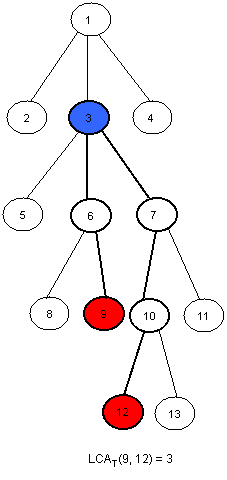
An <O(N), O(sqrt(N))> solution
Dividing our input into equal-sized parts proves to be an interesting way to solve the RMQ problem. This method can be adapted for the LCA problem as well. The idea is to split the tree insqrt(H) parts, were H is the height of the tree. Thus, the first section will contain the levels numbered from 0 to sqrt(H) - 1, the second will contain the levels numbered from sqrt(H) to 2 * sqrt(H) - 1, and so on. Here is how the tree in the example should be divided:
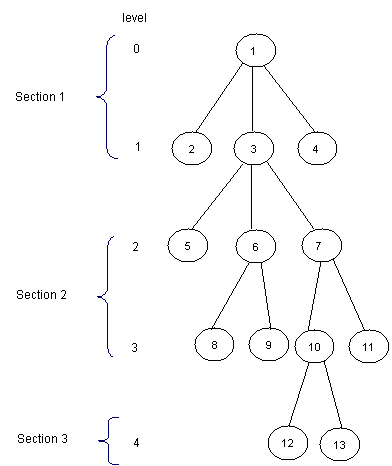
Now, for each node, we should know the ancestor that is situated on the last level of the upper next section. We will preprocess this values in an array P[1, MAXN]. Here is how P should look like for the tree in the example (for simplity, for every node i in the first section let P[i] = 1):

Notice that for the nodes situated on the levels that are the first ones in some sections, P[i] = T[i]. We can preprocess P using a depth first search (T[i] is the father of node i in the tree, nr is[sqrt(H)] and L[i] is the level of the node i):
void dfs(int node, int T[MAXN], int N, int P[MAXN], int L[MAXN], int nr) {
int k;
//if node is situated in the first
//section then P[node] = 1
//if node is situated at the beginning
//of some section then P[node] = T[node]
//if none of those two cases occurs, then
//P[node] = P[T[node]]
if (L[node] < nr)
P[node] = 1;
else
if(!(L[node] % nr))
P[node] = T[node];
else
P[node] = P[T[node]];
for each son k of node
dfs(k, T, N, P, L, nr);
}
Now, we can easily make queries. For finding LCA(x, y) we we will first find in what section it lays, and then trivially compute it. Here is the code:
int LCA(int T[MAXN], int P[MAXN], int L[MAXN], int x, int y)
{
//as long as the node in the next section of
//x and y is not one common ancestor
//we get the node situated on the smaller
//lever closer
while (P[x] != P[y])
if (L[x] > L[y])
x = P[x];
else
y = P[y];
//now they are in the same section, so we trivially compute the LCA
while (x != y)
if (L[x] > L[y])
x = T[x];
else
y = T[y];
return x;
}
This function makes at most 2 * sqrt(H) operations. Using this approach we get an <O(N), O(sqrt(H))> algorithm, where H is the height of the tree. In the worst case H = N, so the overall complexity is <O(N), O(sqrt(N))>. The main advantage of this algorithm is quick coding (an average Division 1 coder shouldn't need more than 15 minutes to code it).
Another easy solution in <O(N logN, O(logN)>
If we need a faster solution for this problem we could use dynamic programming. First, let's compute a table P[1,N][1,logN] where P[i][j] is the 2j-th ancestor of i. For computing this value we may use the following recursion:
The preprocessing function should look like this:
void process3(int N, int T[MAXN], int P[MAXN][LOGMAXN])
{
int i, j;
//we initialize every element in P with -1
for (i = 0; i < N; i++)
for (j = 0; 1 << j < N; j++)
P[i][j] = -1;
//the first ancestor of every node i is T[i]
for (i = 0; i < N; i++)
P[i][0] = T[i];
//bottom up dynamic programing
for (j = 1; 1 << j < N; j++)
for (i = 0; i < N; i++)
if (P[i][j - 1] != -1)
P[i][j] = P[P[i][j - 1]][j - 1];
}
This takes O(N logN) time and space. Now let's see how we can make queries. Let L[i] be the level of node i in the tree. We must observe that if p and q are on the same level in the tree we can compute LCA(p, q) using a meta-binary search. So, for every power j of 2 (between log(L[p]) and 0, in descending order), if P[p][j] != P[q][j] then we know that LCA(p, q) is on a higher level and we will continue searching for LCA(p = P[p][j], q = P[q][j]). At the end, both p and q will have the same father, so return T[p]. Let's see what happens if L[p] != L[q]. Assume, without loss of generality, that L[p] < L[q]. We can use the same meta-binary search for finding the ancestor of p situated on the same level with q, and then we can compute the LCA as described below. Here is how the query function should look:
int query(int N, int P[MAXN][LOGMAXN], int T[MAXN],
int L[MAXN], int p, int q)
{
int tmp, log, i;
//if p is situated on a higher level than q then we swap them
if (L[p] < L[q])
tmp = p, p = q, q = tmp;
//we compute the value of [log(L[p)]
for (log = 1; 1 << log <= L[p]; log++);
log--;
//we find the ancestor of node p situated on the same level
//with q using the values in P
for (i = log; i >= 0; i--)
if (L[p] - (1 << i) >= L[q])
p = P[p][i];
if (p == q)
return p;
//we compute LCA(p, q) using the values in P
for (i = log; i >= 0; i--)
if (P[p][i] != -1 && P[p][i] != P[q][i])
p = P[p][i], q = P[q][i];
return T[p];
}
Now, we can see that this function makes at most 2 * log(H) operations, where H is the height of the tree. In the worst case H = N, so the overall complexity of this algorithm is <O(N logN), O(logN)>. This solution is easy to code too, and it's faster than the previous one.
Reduction from LCA to RMQ
Now, let's show how we can use RMQ for computing LCA queries. Actually, we will reduce the LCA problem to RMQ in linear time, so every algorithm that solves the RMQ problem will solve the LCA problem too. Let's show how this reduction can be done using an example:
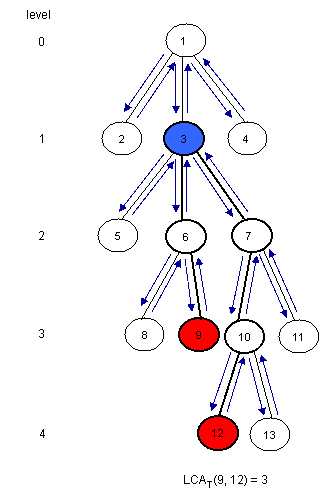
Notice that LCAT(u, v) is the closest node from the root encountered between the visits of u and v during a depth first search of T. So, we can consider all nodes between any two indices of uand v in the Euler Tour of the tree and then find the node situated on the smallest level between them. For this, we must build three arrays:
- E[1, 2*N-1] - the nodes visited in an Euler Tour of T; E[i] is the label of i-th visited node in the tour
- L[1, 2*N-1] - the levels of the nodes visited in the Euler Tour; L[i] is the level of node E[i]
- H[1, N] - H[i] is the index of the first occurrence of node i in E (any occurrence would be good, so it's not bad if we consider the first one)
Assume that H[u] < H[v] (otherwise you must swap u and v). It's easy to see that the nodes between the first occurrence of u and the first occurrence of v are E[H[u]...H[v]]. Now, we must find the node situated on the smallest level. For this, we can use RMQ. So, LCAT(u, v) = E[RMQL(H[u], H[v])] (remember that RMQ returns the index). Here is how E, L and H should look for the example:
Notice that consecutive elements in L differ by exactly 1.
From RMQ to LCA
We have shown that the LCA problem can be reduced to RMQ in linear time. Here we will show how we can reduce the RMQ problem to LCA. This means that we actually can reduce the general RMQ to the restricted version of the problem (where consecutive elements in the array differ by exactly 1). For this we should use cartesian trees.
A Cartesian Tree of an array A[0, N - 1] is a binary tree C(A) whose root is a minimum element of A, labeled with the position i of this minimum. The left child of the root is the Cartesian Tree of A[0, i - 1] if i > 0, otherwise there's no child. The right child is defined similary for A[i + 1, N - 1]. Note that the Cartesian Tree is not necessarily unique if A contains equal elements. In this tutorial the first appearance of the minimum value will be used, thus the Cartesian Tree will be unique. It's easy to see now that RMQA(i, j) = LCAC(i, j).
Here is an example:

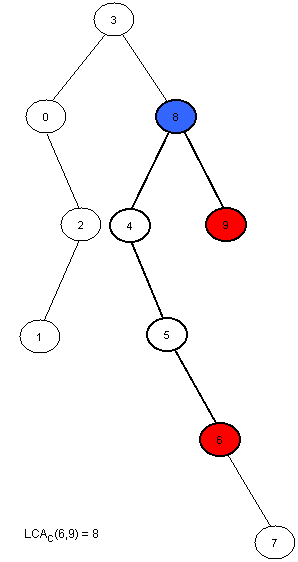
Now we only have to compute C(A) in linear time. This can be done using a stack. At the beginning the stack is empty. We will then insert the elements of A in the stack. At the i-th step A[i]will be added next to the last element in the stack that has a smaller or equal value to A[i], and all the greater elements will be removed. The element that was in the stack on the position ofA[i] before the insertion was done will become the left son of i, and A[i] will become the right son of the smaller element behind him. At every step the first element in the stack is the root of the cartesian tree. It's easier to build the tree if the stack will hold the indexes of the elements, and not their value.
Here is how the stack will look at each step for the example above:
| Step | Stack | Modifications made in the tree |
| 0 | 0 | 0 is the only node in the tree. |
| 1 | 0 1 | 1 is added at the end of the stack. Now, 1 is the right son of 0. |
| 2 | 0 2 | 2 is added next to 0, and 1 is removed (A[2] < A[1]). Now, 2 is the right son of 0 and the left son of 2 is 1. |
| 3 | 3 | A[3] is the smallest element in the vector so far, so all elements in the stack will be removed and 3 will become the root of the tree. The left child of 3 is 0. |
| 4 | 3 4 | 4 is added next to 3, and the right son of 3 is 4. |
| 5 | 3 4 5 | 5 is added next to 4, and the right son of 4 is 5. |
| 6 | 3 4 5 6 | 6 is added next to 5, and the right son of 5 is 6. |
| 7 | 3 4 5 6 7 | 7 is added next to 6, and the right son of 6 is 7. |
| 8 | 3 8 | 8 is added next to 3, and all greater elements are removed. 8 is now the right child of 3 and the left child of 8 is 4. |
| 9 | 3 8 9 | 9 is added next to 8, and the right son of 8 is 9. |
Note that every element in A is only added once and removed at most once, so the complexity of this algorithm is O(N). Here is how the tree-processing function will look:
void computeTree(int A[MAXN], int N, int T[MAXN])
{
int st[MAXN], i, k, top = -1;
//we start with an empty stack
//at step i we insert A[i] in the stack
for (i = 0; i < N; i++)
{
//compute the position of the first element that is
//equal or smaller than A[i]
k = top;
while (k >= 0 && A[st[k]] > A[i])
k--;
//we modify the tree as explained above
if (k != -1)
T[i] = st[k];
if (k < top)
T[st[k + 1]] = i;
//we insert A[i] in the stack and remove
//any bigger elements
st[++k] = i;
top = k;
}
//the first element in the stack is the root of
//the tree, so it has no father
T[st[0]] = -1;
}
An<O(N), O(1)> algorithm for the restricted RMQ
Now we know that the general RMQ problem can be reduced to the restricted version using LCA. Here, consecutive elements in the array differ by exactly 1. We can use this and give a fast<O(N), O(1)> algorithm. From now we will solve the RMQ problem for an array A[0, N - 1] where |A[i] - A[i + 1]| = 1, i = [1, N - 1]. We transform A in a binary array with N-1 elements, whereA[i] = A[i] - A[i + 1]. It's obvious that elements in A can be just +1 or -1. Notice that the old value of A[i] is now the sum of A[1], A[2] .. A[i] plus the old A[0]. However, we won't need the old values from now on.
To solve this restricted version of the problem we need to partition A into blocks of size l = [(log N) / 2]. Let A'[i] be the minimum value for the i-th block in A and B[i] be the position of this minimum value in A. Both A and B are N/l long. Now, we preprocess A' using the ST algorithm described in Section1. This will take O(N/l * log(N/l)) = O(N) time and space. After this preprocessing we can make queries that span over several blocks in O(1). It remains now to show how the in-block queries can be made. Note that the length of a block is l = [(log N) / 2], which is quite small. Also, note that A is a binary array. The total number of binary arrays of size l is 2l=sqrt(N). So, for each binary block of size l we need to lock up in a table P the value for RMQ between every pair of indices. This can be trivially computed in O(sqrt(N)*l2)=O(N) time and space. To index table P, preprocess the type of each block in A and store it in array T[1, N/l]. The block type is a binary number obtained by replacing -1 with 0 and +1 with 1.
Now, to answer RMQA(i, j) we have two cases:
- i and j are in the same block, so we use the value computed in P and T
- i and j are in different blocks, so we compute three values: the minimum from i to the end of i's block using P and T, the minimum of all blocks between i's and j's block using precomputed queries on A' and the minimum from the begining of j's block to j, again using T and P; finally return the position where the overall minimum is using the three values you just computed.
Conclusion
RMQ and LCA are strongly related problems that can be reduced one to another. Many algorithms can be used to solve them, and they can be adapted to other kind of problems as well.
Here are some training problems for segment trees, LCA and RMQ:
SRM 310 -> Floating Median
http://acm.pku.edu.cn/JudgeOnline/problem?id=1986
http://acm.pku.edu.cn/JudgeOnline/problem?id=2374
http://acmicpc-live-archive.uva.es/nuevoportal/data/problem.php?p=2045
http://acm.pku.edu.cn/JudgeOnline/problem?id=2763
http://www.spoj.pl/problems/QTREE2/
http://acm.uva.es/p/v109/10938.html
http://acm.sgu.ru/problem.php?contest=0&problem=155
References
- "Theoretical and Practical Improvements on the RMQ-Problem, with Applications to LCA and LCE" [PDF] by Johannes Fischer and Volker Heunn
- "The LCA Problem Revisited" [PPT] by Michael A.Bender and Martin Farach-Colton - a very good presentation, ideal for quick learning of some LCA and RMQ aproaches
- "Faster algorithms for finding lowest common ancestors in directed acyclic graphs" [PDF] by Artur Czumaj, Miroslav Kowaluk and Andrzej Lingas










相关推荐
Range Minimum Query (RMQ) 和 Lowest Common Ancestor (LCA) 是两种在计算机科学和算法设计中常见的数据结构和问题。在这篇文章的翻译中,主要介绍了这两种概念以及它们的关联和解决方案。 首先,Range Minimum ...
**RMQ(Range Minimum Query)与LCA(Lowest Common Ancestor)问题**是图论与数据结构领域中的两个重要概念,广泛应用于算法设计和优化。这篇由郭华阳所著的国家队论文深入探讨了这两个问题及其解决方案。 **RMQ...
【7】RMQ与LCA(Range Minimum Query 和 Lowest Common Ancestor)是高效查询算法。RMQ用于在数组或矩阵中查找指定区间内的最小值,而LCA则是在树上找到两个节点的最近公共祖先,这两个概念在解决动态查询和树形结构...
最近公共祖先(Lowest Common Ancestor,简称LCA)问题在图论和算法中具有重要的地位,特别是在处理树形结构的数据时。LCA问题指的是在一个树形结构中,查找两个指定节点的最近公共祖先,即离这两个节点最近的共同父...
在算法领域,Range Minimum Query (RMQ) 和 Lowest Common Ancestor (LCA) 问题不仅因其自身的挑战性而受到关注,更因为它们在字符串处理、计算生物学以及其他复杂数据结构中的广泛应用而显得尤为重要。本文将深入...
LCA(Lowest Common Ancestor)和 RMQ(Range Minimum Query)是两种常见的数据结构算法问题。LCA 问题的目的是在一棵树中找到两个结点的最近公共祖先,而 RMQ 问题的目的是在一个数组中找到两个索引之间的最小值的...
**六、LCA(Lowest Common Ancestor)与RMQ的关系** 在树结构中,LCA(最近公共祖先)问题与RMQ问题有密切关系。通过解决LCA问题,可以进一步解决树上的一类RMQ问题。例如,可以利用树的LCA信息来高效地找到树上两...
其次,RMQ(Range Minimum Query)问题是在数组或序列中寻找一段连续子区间内的最小值。这个问题在动态数据处理、最优化问题等领域有着广泛应用。常见的解决方法有线段树和ST表(Sqrt-Decomposition)。线段树是一种...
5.1.2 Lowest Common Ancestor (LCA) 53 5.1.3 Reduction from LCA to RMQ 56 5.1.4 From RMQ to LCA 57 5.1.5 An(N), O(1)> algorithm for the restricted RMQ 60 5.1.6 An AC programme 61 5.2 最长公共子序列LCS ...
最低公共祖先(Lowest Common Ancestor,简称LCA)算法是数据结构与算法中的一个重要概念,主要用于处理树形结构的问题,比如在二叉树、树状数组或图中找到两个节点的最近公共祖先。在本项目中,它通过C++语言实现,...
RMQ(Range Minimum Query,区间最小值查询)与LCA(Lowest Common Ancestor,最近公共祖先)是两种常见的算法问题,广泛应用于数据结构、图论以及计算机科学竞赛中。 RMQ问题通常涉及到在一个给定的线性序列A中,...
最近公共祖先(Lowest Common Ancestor,简称LCA)是图论中的一个重要概念,主要应用于树形结构的数据问题。在给定的树中,两个节点的最近公共祖先是指距离这两个节点最近的那个共同父节点。在计算机科学中,尤其是...
- **RMQ (Range Minimum Query)**:这是用来查找给定区间内最小值的数据结构。它支持在常数时间内查询区间最小值,通常通过线段树或者斐波那契堆实现。 2. **LCA (Lowest Common Ancestor)**:在树结构中,LCA算法...
首先,我们来理解什么是RMQ(Range Minimum Query),即区间最值查询。RMQ问题是要找出数组中某一段连续子数组的最小值。例如,给定数组[1, 3, 2, 5, 4],对于区间[1, 3],其RMQ结果是2;对于区间[2, 5],其RMQ结果...
LCA算法是树上问题的基础,常见的有基于RMQ(Range Minimum Query,区间最值查询)的O(n log^2 n)方法和Tarjan的O(n)预处理方法。 - **树上距离查询**:通过LCA可以快速计算两个节点间的最短路径,这对于解决树上的...
这份论文集涵盖了多个关键的算法和理论主题,包括欧拉回路、线性规划、动态树、RMQ(Range Minimum Query,区间最小值查询)与LCA(Lowest Common Ancestor,最近公共祖先)、以及最小割等。这些知识点在计算机科学...
LCA(Lowest Common Ancestor)问题则是针对树形结构的一个经典问题,它要求找出树中两个节点的最近公共祖先。最近公共祖先指的是在树中,同时是两个给定节点的祖先,并且离根节点最近的节点。LCA 问题在图论、数据...
本文将深入探讨“最低共同祖先(Lowest Common Ancestor, LCA)”这一主题,它是树数据结构中的核心问题。Yandex_tree_3.rar_tree 文件可能包含了关于这个算法的具体实现或相关测试数据。 最低共同祖先问题指的是,...
这个模板可能包含计算二叉树或树中任意两个节点最近公共祖先的算法,如Mo's Algorithm或基于RMQ(Range Minimum Query)的数据结构。 3. **KMP.cpp**:KMP算法是一种字符串匹配算法,用于在一个文本串中查找一个...
- 树状数组、后缀数组、TRIE树(K叉树和左儿子右兄弟模型)、RMQ(Range Minimum/Maximum Query)问题的解决策略。 - LCA(Lowest Common Ancestor)问题的不同解法。 - 带权值的并查集、快速排序、大数运算、最长...